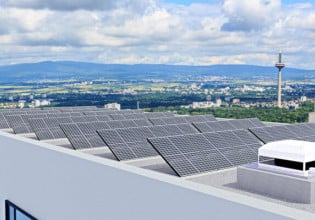SolarWindow sets Record for Generating Electricity while being Transparent
New Energy Technologies Inc., developer of see-through SolarWindow™ coatings, capable of generating electricity on glass and flexible plastics, today announced that its technology has set a new record for generating electricity while remaining see-through with over 50% greater power than prior attempts publicized by others. Using today's certified power-production data, company engineers estimate that a SolarWindow installation on a fifty-story commercial building located in Florida could generate enough electricity to power at least 100 homes while eliminating the equivalent carbon emissions produced by vehicles driving approximately 2,750,000 miles per year.
The company's announcement is based on results of independent testing and certification of its SolarWindow modules by the U.S. Department of Energy's National Renewable Energy Laboratory (NREL). Based on this newly validated data from the high-performance modules unveiled on March 26, 2014, New Energy's review of prevailing published literature and scientific reports confirmed that SolarWindow modules outperform publicized devices of comparable architecture, size, and design by over 53% in terms of power production -- a major achievement and new record. The company's certified, high-performance module is the most efficient organic photovoltaic (OPV) module ever measured by NREL's Device Performance Measurement Laboratory.
Typically, OPV performance tests are conducted on small 'lab-scale' devices, which generally measure only 1 square inch or smaller due to the challenging nature of OPV scale-up for see-through (semi-transparent) devices. New Energy's latest, high-performance SolarWindow module measures 36 square inches (232 square centimeters).
"We've long been confident that our SolarWindow modules are more power efficient and larger than any other like-technology. Now, our target customers - engineers, glass companies, architects, and building developers - know this to be the case," announced Mr. John A. Conklin, President and CEO of New Energy Technologies.
"We are engineering our see-through SolarWindow products to generate sustainable electricity, and be aesthetically attractive, while being developed at a cost which makes economic sense to our customers," continued Mr. Conklin. "We also remain mindful of ease-of-manufacturing, scale-up of size, and overall environmental benefits -- all important considerations for our potential customers and future commercial partners in the commercial buildings sector."
Company engineers envision installing SolarWindow on the vast areas of tinted glass surfaces on commercial buildings. In contrast, conventional solar power systems are limited to very small rooftop areas on skyscrapers and tall towers, which are already crowded with service systems such as HVAC services and elevators; tenant-amenities such as rooftop gardens and pools; and other high-footprint features.
"We've worked hard to achieve both large-scale and high power conversion efficiency," explained Dr. Scott Hammond, Principal Scientist at New Energy Technologies. "Our record-breaking SolarWindow module is the result of various methods of fabrication and materials, which have helped us overcome numerous challenges unique to our OPV device technology. I'm grateful for the support of the talented scientific team at NREL, who have helped us achieve this very significant milestone."
The Company's high-performance, large-area SolarWindow has been fabricated through the efforts of New Energy's Principal Scientist, Dr. Scott Hammond, in collaboration with NREL Researchers, particularly Dr. Maikel van Hest, Dr. Dana C. Olson, and Dr. Scott Mauger.
"As NREL researchers, part of our mandate is to help companies move their renewable energy technologies closer to commercialization," explained Dr. Maikel van Hest, Senior Scientist at NREL. "It's wonderful to contribute to breakthroughs such as this latest achievement, an important step in commercialization of their technology."
NREL is among the world's most respected and advanced solar-photovoltaic research institutions, and over its 37-year history has been credited for ground-floor support of many of the commercial technologies employed by today's renewable energy industries.
NREL and New Energy have been working through a Cooperative Research and Development Agreement to advance the company's SolarWindow technology for generating electricity on glass windows. The NREL Device Performance Measurement Laboratory is the premier U.S. Department of Energy research laboratory for testing performance of commercial, developmental, and research photovoltaic (PV) devices. The Device Performance group is one of only two laboratories in the world to hold an International Organization for Standardization (ISO) 17025 accreditation for primary reference cell and secondary module calibration, in addition to accreditation for secondary reference cell calibration under American Society for Testing Materials (ASTM), and International Electrotechnical Commission (IEC) standards.






